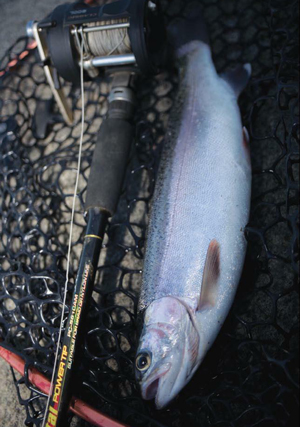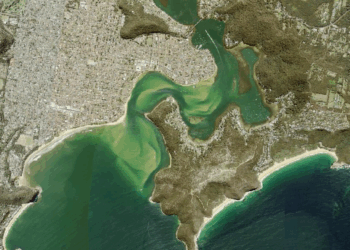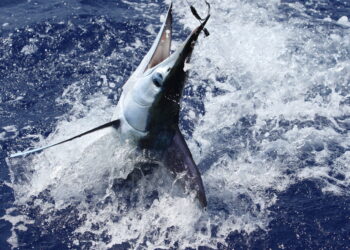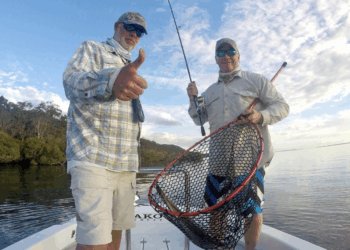The Fishing School with Pat Brennan
IN last month’s Fishing School we went through setting yourself up with a lead core line outfit as a deadly trout trolling tool for trout, especially in winter. This time, we’re going to take your well balanced and perfectly rigged lead core outfit and start learning how to use it.
Let’s firstly examine why we use lead core. Because the line contains lead it’s heavy and sinks quickly. When attached to a lure it drags the lure down with it. This allows you to fish lures well beyond their inbuilt depth capabilities. In turn, this also allows the angler to deliberately fish more of the water column in order to locate at what depth fish may be congregating. Sometimes, this may be close to the bottom, mid-water or even close to the surface. Lead core line isn’t a way of “always” being able to get a lure to the fish, but it is a versatile and uncomplicated method of searching out a range of depths.
So, when would you fish with lead core? Personally, I wouldn’t contemplate fishing the alpine lakes without a lead core outfit. The only time I wouldn’t have one in the water would be when I was specifically fishing very shallow water or when any strikes are coming from shallow running outfits, which isn’t that often.
When choosing a lead core outfit you are consciously deciding to fish a particular depth. So, you could reasonably presume that a certain amount of lead core equals a particular depth. I often hear or read fishing reports of “trout being taken on lead core line at two colours”, for example. That infers that if everyone feeds out two colours of lead core, they’ll all have their lures at the same depth. Nothing could be further from the truth. Here are a couple of reasons why this is. The weight of the lead core you use will dictate how deep it goes. I have advocated 18lb as being a good general line but some guys use 28lb so obviously their lures are going to be deeper at two colours than the same amount of 18lb line.
Trolling speed also affects depth. Boat speed is crucial in all trolling but there are additional factors when trolling with lead core. But the faster you go the shallower your lead core outfit will run. On my boat I have a depth sounder with an integrated GPS unit. This tells me my speed over land. Having done some pretty comprehensive testing a few years ago, I know that when trolling with an electric motor at between 1.8 and 2kph, running two colours of 18lb lead core line with a four metre leader and Rapala shallow running minnow, my lure is pretty close to spot on to eight metres down. Slow down and the lures run deeper, speed up and the lures run shallower. Also, put a heavier or deeper diving lure on, like a Tasmanian Devil, and it will run a little deeper still. I also know that while trolling along at these speed/depth combination, if I sound a snag (submerged tree) that comes up to five metres, speeding up to 3.8kph will generally clear the snag without having to wind lines in. This is because the increased speed provides greater resistance against the line and lifts it quite significantly in the water column.
If you only troll on a petrol motor it will almost be impossible to troll at speeds as slow as I’ve indicated (in fact, many people who have electric motors still don’t troll as slow as I do, but that’s another story!). So you might be using identical outfits to me but running at half the depth. While there’s nothing wrong with that, it’s important, however, that you know the depth your lures are running at. If you are, or want to be, serious about your trout trolling, I strongly suggest you set aside a few hours one day when the fish aren’t biting too well and experiment with trolling speeds and lure depths.
Your choice of lure is still quite personal. For what it is worth, I would fish 90 per cent of my lead core time with a Rapala F5, 7 or 9 in either Rainbow Trout, Brown Trout or Minnow colours. Otherwise I’ll use a Tassie Devil in either pink or yellow wing, but I know plenty of people who use heaps of other lures with good success.
To bring all it all together, unless I have intelligence that makes me decide to fish differently, I start my winter trout trolling in water depths of 8-15m, which usually means the margins of a lake. I have a lead core outfit (for each person in the boat) set at two colours out and troll at about 2ph. I also have a shallow running outfit (for each person in the boat) with a lure running between 1-3m deep.
I fish with my lead core reels in strike drag at a moderate to light setting. I know others who leave the reels in free spool with the ratchet on. When a fish strikes, the reels screams and the weight of the line and the low stretch aids in setting the hooks. You then engage the gears on drive the hooks home. I’ve tried both methods and believe the strike method works for me, mainly, I believe, because my method of trolling so slowly doesn’t provide enough strike pressure to set the hooks.
Well, that’s fishing with lead core line in a nutshell. I hope you use these ideas to catch some more trout.


















